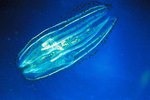
The different species of box jellyfish are divided into two types: cubozoans and carybdeids. The first type has more than one tentacle hanging from each corner or pedalia, which are muscular pads at the bottom and inside of the bell. The second type of box jellyfish, the carybdeids, have only one tentacle per pedalia. Stings from box jellyfish with more than one tentacle at each corner are more dangerous to humans.
Sea Wasp
Known scientifically as chironex fleckeri, this box jellyfish is known more as the sea wasp and aptly earns its moniker. According to Deadliest Creature, each individual sea wasp has enough venom to kill 60 people. A sting from this sea critter can kill a human within four minutes. The bell of a sea wasp can become as large as a basketball and its trailing tentacles can grow as long as 15 feet. It is not an aggressive species but rather inadvertently stings swimmers sharing the same water space off the coast of Australia, New Guinea, the Philippines and Vietnam.
Irukandji
This box jellyfish species also lives in the waters off Australia. However, this critter's small size, with a bell of only 2.5 cm in diameter with only one tentacle per pedalia, makes it much more difficult to spot as compared to the sea wasp. The size difference does not make it any less deadly. Named after a group of aboriginal peoples living on the northern Australian coast, its scientific name is Carukia barnesi. Its sting feels at first similar to that of a mosquito bite, but it quickly turns into its namesake syndrome -- Irukandji syndrome -- featuring severe pain, headaches, cramps, sweating, vomiting, and an increase in blood pressure and heart rate. Medical treatment is advised.
Mangrove
This box jellyfish species takes its common name from the mangrove swamps and lagoons of the Gulf of Mexico, Caribbean, Central America and South America that it prefers to inhabit. This is one of the smaller species of box jellyfish, growing to the size of a silver dollar. It lives in large population groups near the surface of the water where it can prey easily on small crustaceans. Unlike other jellyfish that are clear or whitish in color, the mangrove has color variations from greenish gray to brownish yellow. Scientifically, this species is known as tripedalia cystophora.
Newcomer From Africa
In 2008, scientists studying box jellyfish off the coast of South Africa discovered a new species. Scientifically known as Carybdea branchi, this box jellyfish is found in abundant numbers in Cape Town Harbour, according to the University of the Western Cape. It previously was misidentified as a sea wasp, but as researchers took a closer look at this box jellyfish they documented enough distinctions to reclassify it based on its colorful appearance and densely scattered warts on its body. Its sting is harmful, but not as lethal as a sea wasp.
References
- James Cook University: How Many Different Types of Box Jellyfish are There?
- Monterey Bay Aquarium: Box Jelly
- Extreme Science: Deadliest Creature: Sea Wasp
- Marine Species Identification Portal: Zooplankton of the South Atlantic Ocean: Tripedalia Cystophora
- The Journal Of Experimental Biology: Visual Control of Steering In The Box Jellyfish Tripedalia Cystophora
- Lamar University: Mangrove Jellyfish
- Australian Fauna: Irukandji Jellyfish
- Real Monstrosities: Irukandji Jellyfish
- Discovery: Scientistis Unravel Evolution of Highly Toxic Box Jellyfish
- University Of The Western Cape: SAJellyWatch -- Common Jellyfish Around South And Southern Africa
Resources
Photo Credits
-
Karl Weatherly/Photodisc/Getty Images
Writer Bio
Amy M. Armstrong is a former community news journalist with more than 15 years of experience writing features and covering school districts. She has received more than 40 awards for excellence in journalism and photography. She holds a Bachelor of Arts in communications from Washington State University. Armstrong grew up on a dairy farm in western Washington and wrote agricultural news while in college.



